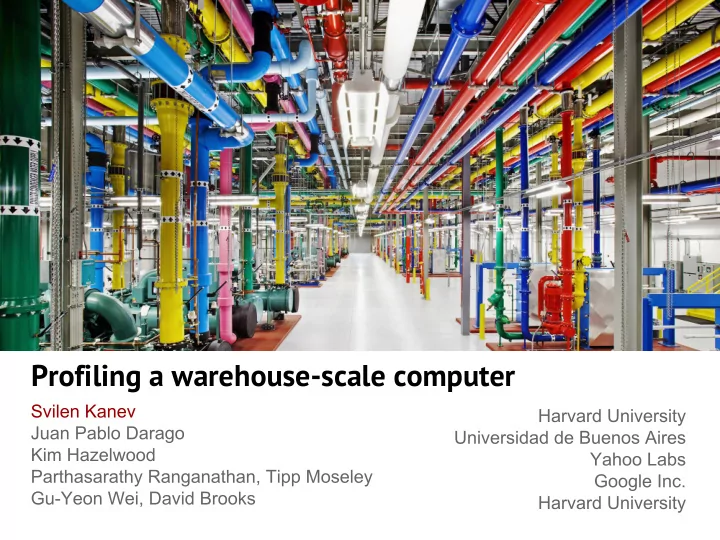

Profiling a warehouse-scale computer Svilen Kanev Harvard University Juan Pablo Darago Universidad de Buenos Aires Kim Hazelwood Yahoo Labs Parthasarathy Ranganathan, Tipp Moseley Google Inc. Gu-Yeon Wei, David Brooks Harvard University
The cloud is here to stay [http://google.com/trends, 2015] 2
Warehouse-scale computers (of yore) datacenters built around a few “killer workloads” problem sizes >> 1 machine ... distributed, but tightly interconnected services communication through remote-procedure calls (RPCs) 3
Now “the datacenter is the computer” (the WSC model has caught on) “microservice architecture” Did you mean: #pldi15 thousands of services are “one RPC away” “... about a hundred of services that comprise Siri’s backend...” [Apple, Mesos meetup 2015] frequency[“#isca15”]++ 4
How do modern WSC applications interact with hardware? And what does that imply for future server processors?
Traditional profiling: load testing Isolate a service Find representative inputs Find representative operating point Profile / optimize Repeat 6
Live datacenter-scale profiling (Google-wide profiling) Select random production machines ~20,000 / day Profile each one (for a while) without isolation while running live traffic for billions of users GWP DB Aggregate days, weeks, years worth of execution [Ren et al. Google-wide profiling , 2010] 7
Live WSC profiling insights Where are cycles spent in a datacenter? Are there really no killer applications? How do WSC applications interact with instruction caches? How much ILP is there? Big / small cores? DRAM latency vs. bandwidth? Hyperthreading? 8
Where are WSC cycles spent?
No “killer” application to optimize for [1 week of sampled WSC cycles] Instead: a long tail of various different services 10
Ongoing application diversification [~3 years of sampled WSC cycles] Optimizing hardware one-application-at-a-time has diminishing returns 11
Within applications: no hotspots [search leaf node; 1 week of cycles] Corollary: hunting for per-application hotspots is not justified 12
Hotspots across applications: “datacenter tax’’ Shared low-level routines; typical for larger-than-1-server problems 13
Hotspots across applications: “datacenter tax’’ Only 6 self-contained routines account for ~30% of WSC cycles Prime candidates for accelerators in server SoCs 14
Live WSC profiling insights Where are cycles spent in a datacenter? Everywhere. Are there really no killer applications? Datacenter tax. How do WSC applications interact with instruction caches? How much ILP is there? Big / small cores? DRAM latency vs. bandwidth? Hyperthreading? 15
Microarchitecture: WSC i-cache pressure
Severe instruction cache bottlenecks 20,000 Intel IvyBridge servers 15-30% of core cycles wasted on 2 days instruction-supply stalls Top-Down analysis [Yasin 2014] 17
Severe instruction cache bottlenecks 15-30% of core cycles wasted on Fetching instructions from L3 caches instruction-supply stalls Very high i-cache miss rates 10x the highest in SPEC 50% higher than CloudSuite Lots of lukewarm code 100s MBs of instructions per binary; no hotspots 18
A problem in the making I-cache working sets 4-5x larger than largest in SPEC Growing almost 30% / year significantly faster than i-caches One solution: L2 i/d partitioning 19
Live WSC profiling insights Where are cycles spent in a datacenter? Everywhere. Are there really no killer applications? Datacenter tax. How do WSC applications interact with instruction caches? Poorly. How much ILP is there? Big / small cores? Bimodal. DRAM latency vs. bandwidth? Latency. Hyperthreading? Yes. 20
To sum up A growing number of programs cover “the world’s WSC cycles”. There is no “killer application”, and hand-optimizing each program is suboptimal. Low-level routines (datacenter tax) are a surprisingly high fraction of cycles. Good candidates for accelerators in future server processors. Common microarchitectural footprint: working sets too large for i-caches; many d- cache stalls; generally low IPC; bimodal ILP; low memory bandwidth utilization.
Recommend
More recommend